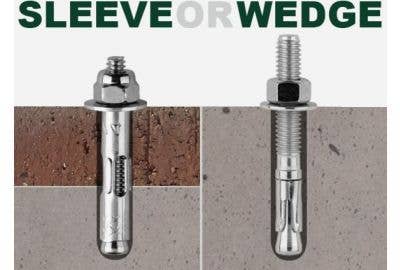Imagine you’re building a deck. You’ve laid the foundation, and now it’s time to attach the wooden beams. But these beams need to be secure, able to withstand the weight of people, furniture, and even the occasional gust of wind. How do you ensure stability? Enter the anchor. These unsung heroes of construction hold everything together, but choosing the right one for the job can be a headache.

Image: lhdottie.com
This guide delves into the world of sleeve anchors and wedge anchors, two common yet distinct fastening systems used in countless projects. We’ll break down their differences, highlight their strengths and weaknesses, and help you determine which anchor fits your specific needs.
Understanding the Basics
Both sleeve and wedge anchors are mechanical fasteners designed to secure objects like beams, posts, and brackets to concrete or masonry. But their internal mechanisms and applications differ significantly, making one a better choice than the other depending on the project’s specific demands.
Sleeve Anchors: The Flexible Choice
Imagine a hollow tube with an expanding mechanism inside. That’s the essence of a sleeve anchor. These anchors rely on a sleeve (the tube) that is inserted into a pre-drilled hole and expands as the screw is tightened. The sleeve then grips the surrounding concrete, providing a secure hold.
Advantages:
- Flexibility: Sleeve anchors are compatible with a wide range of screw sizes and diameters.
- Ease of Installation: They are relatively simple to install, requiring minimal tools and expertise.
- Cost-Effective: Sleeve anchors are often more affordable than wedge anchors.
Disadvantages:
- Limited Load Capacity: While suitable for lighter applications, sleeve anchors may not be robust enough for heavy loads.
- Potential for Damage: Over-tightening can cause the sleeve to deform or damage the surrounding concrete.
- Uneven Grip: Depending on the material, the sleeve may not grip the concrete evenly, potentially leading to a weakened hold.
Wedge Anchors: The Powerhouse
Wedge anchors operate differently. They feature a tapered wedge that is driven into a pre-drilled hole, creating a powerful expansion force that anchors the object into the concrete.
Advantages:
- High Load Capacity: Wedge anchors offer exceptional strength and can handle substantial weight.
- Secure Grip: The wedge’s expansion creates a strong and reliable hold, minimizing the risk of slippage or loosening.
- Resistant to Vibration: Wedge anchors are ideal for applications where vibration or movement is expected.
Disadvantages:
- Limited Screw Sizes: Wedge anchors typically have a limited range of compatible screw sizes.
- More Difficult Installation: Installation requires specialized tools like hammer drills and setting tools.
- Higher Cost: Wedge anchors tend to be more expensive than sleeve anchors.

Image: www.youtube.com
Sleeve vs. Wedge: A Comparative Overview
The following table summarizes the key differences between sleeve and wedge anchors to provide a clear overview:
| Feature | Sleeve Anchor | Wedge Anchor |
|---|---|---|
| Installation | Relatively Easy | More Complex |
| Load Capacity | Moderate | High |
| Flexibility | High | Limited |
| Cost | Lower | Higher |
| Durability | Moderate | High |
| Applications | General Use | Heavy-duty loads |
Choosing the Right Anchor
The optimal choice between sleeve and wedge anchors depends on your project’s demands.
Choose a sleeve anchor for:
- Lightweight applications such as hanging shelves, decorative elements, or light fixtures.
- Projects where installation speed and ease are crucial.
- Applications where a wide range of screw sizes is required.
- Budget-conscious projects.
Choose a wedge anchor for:
- Heavy-duty applications involving significant weight or stress, such as structural beams, heavy machinery, or large signs.
- Applications where vibration or impact loads are present.
- Projects requiring maximum security and reliability.
Expert Insights: Building on Knowledge
Experienced contractors and engineers recommend careful consideration of the following factors when selecting an anchor:
- Material Strength: Consider the weight and load the anchor will bear.
- Installation Method: Assess the available tools and skillset for installation.
- Environmental Factors: Account for exposure to moisture, temperature fluctuations, or vibrations.
- Code Requirements: Ensure compliance with local building codes for structural integrity.
Actionable Tips: Level Up Your Construction
- Consult a Professional: For complex or critical projects, seek expert guidance from a construction professional before selecting and installing anchors.
- Measure Twice, Drill Once: Precise drilling is crucial for proper anchor function.
- Test the Anchor: Before attaching the final object, test the anchor’s holding strength to ensure it meets the project’s requirements.
- Maintain Regular Inspections: Inspect the anchors periodically to check for signs of wear or loosening.
Sleeve Vs Wedge Anchor
Conclusion: Unleashing the Power of Anchors
Choosing between sleeve and wedge anchors is a critical decision in any construction project. Understanding their strengths, weaknesses, and specific applications provides the foundation for a strong and stable structure. Remember to consult professional advice, prioritize safety, and build with confidence, knowing that the right anchor can hold your projects together for years to come.
Now, share this valuable information with fellow builders and contribute to the world of strong and safe construction!






